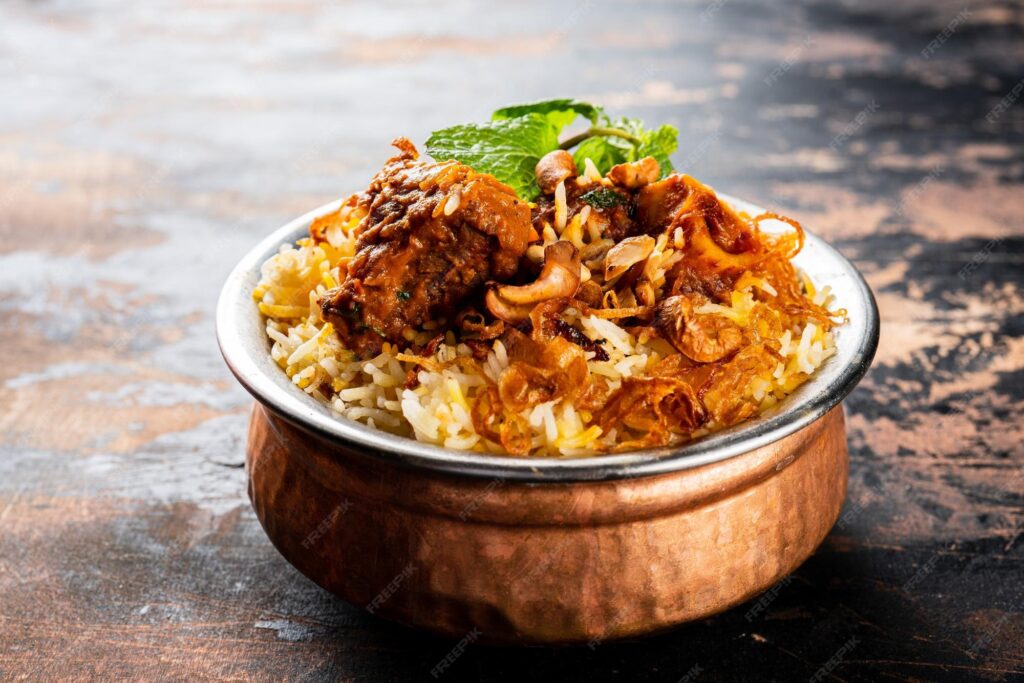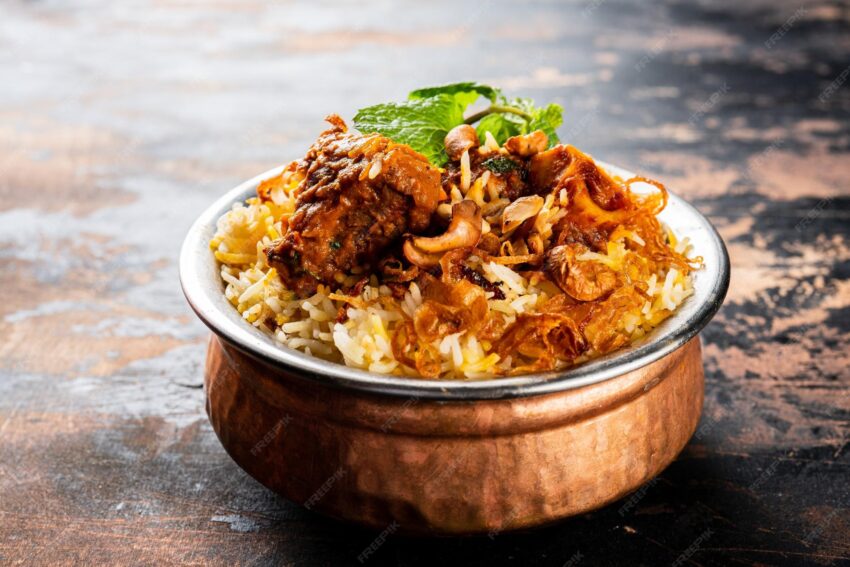
Mutton Biryani Types: A Culinary Exploration & Expert Guide
Mutton biryani, a symphony of fragrant rice, tender mutton, and aromatic spices, holds a revered place in South Asian cuisine. But beyond the familiar dish lies a world of diverse preparations, each reflecting regional nuances, culinary traditions, and unique flavor profiles. This comprehensive guide delves into the fascinating universe of mutton biryani types, offering an expert exploration of the ingredients, techniques, and stories behind these culinary masterpieces. We will explore the varieties, the subtle differences and help you appreciate the authentic versions that should be on your culinary bucket list.
Whether you’re a seasoned biryani aficionado or a curious food enthusiast, this article will equip you with the knowledge to differentiate between various mutton biryani styles, appreciate their distinct characteristics, and even attempt recreating them in your own kitchen. Prepare to embark on a flavorful journey through the diverse landscape of mutton biryani, where every bite tells a story.
Understanding the Essence of Mutton Biryani
Before diving into the specific types, let’s establish a foundational understanding of what constitutes mutton biryani. At its core, biryani is a mixed rice dish made with meat (in this case, mutton), rice, and a blend of spices. The key lies in the layering and slow cooking process, which allows the flavors to meld together, resulting in a harmonious and aromatic dish. However, the specific ingredients, cooking methods, and regional influences lead to a wide array of variations.
Historically, biryani is believed to have originated in Persia or Central Asia and was brought to India by the Mughals. Over time, the dish adapted to local ingredients and tastes, resulting in the diverse range of biryani types we see today.
The quality of the mutton is paramount. Traditionally, cuts like the shoulder or leg, which benefit from slow cooking, are preferred. The rice used is typically long-grain basmati, known for its aroma and fluffy texture. The spices vary depending on the region, but common ingredients include cardamom, cloves, cinnamon, bay leaves, saffron, and various chili powders.
Exploring the World of Mutton Biryani Types
Let’s embark on a journey through the most popular and distinctive mutton biryani types:
Hyderabadi Mutton Biryani: The Crown Jewel
Hailing from Hyderabad, India, this biryani is renowned for its rich flavors and aromatic spices. It is typically prepared using the ‘kacchi yakhni’ method, where raw mutton is marinated in spices and yogurt and then layered with partially cooked rice. The biryani is then slow-cooked (‘dum’) over low heat, allowing the flavors to infuse and the mutton to become incredibly tender.
Key ingredients include saffron, rose water, and kewra water, which contribute to the biryani’s distinctive fragrance. The mutton is often marinated with papaya paste to tenderize it further. Hyderabadi biryani is known for its subtle sweetness and delicate balance of spices.
Expert Tip: The key to authentic Hyderabadi biryani is the slow cooking process. The ‘dum’ technique ensures that the flavors meld together perfectly and the mutton becomes incredibly tender.
Lucknowi (Awadhi) Mutton Biryani: The Subtle Aristocrat
Originating from Lucknow, the capital of Uttar Pradesh, India, Lucknowi biryani is characterized by its delicate flavors and subtle aroma. Unlike Hyderabadi biryani, Lucknowi biryani uses the ‘pakki’ method, where the mutton and rice are cooked separately before being layered and finished on ‘dum’.
The mutton is typically cooked in a rich gravy (‘yakhni’) with a blend of aromatic spices, including cardamom, cloves, and saffron. The rice is cooked separately and then layered with the mutton and gravy. The biryani is then slow-cooked on ‘dum’ to allow the flavors to meld together.
Lucknowi biryani is known for its subtle flavors and delicate aroma. It is less spicy than Hyderabadi biryani and focuses on showcasing the natural flavors of the mutton and rice. Rose water and kewra water are often used to enhance the fragrance.
Calcutta Mutton Biryani: The Potato Twist
A unique variation from Kolkata (Calcutta), India, this biryani is distinguished by the addition of potatoes. The potatoes are typically boiled and fried before being added to the biryani, contributing a creamy texture and subtle sweetness.
Calcutta biryani is influenced by both Lucknowi and Hyderabadi styles. It uses the ‘pakki’ method, with the mutton and rice cooked separately before being layered and finished on ‘dum’. However, it incorporates potatoes, which are not traditionally found in other biryani types.
The biryani is typically flavored with a blend of aromatic spices, including cardamom, cloves, and cinnamon. Rose water and saffron are also used to enhance the fragrance and flavor. The mutton is often cooked in a rich gravy (‘yakhni’) before being layered with the rice and potatoes.
Sindhi Mutton Biryani: The Tangy Delight
From the Sindh province of Pakistan, Sindhi biryani is known for its tangy and spicy flavors. It incorporates ingredients like plums, potatoes, and yogurt, contributing to its distinctive taste profile.
Sindhi biryani uses the ‘pakki’ method, with the mutton and rice cooked separately before being layered and finished on ‘dum’. The mutton is typically cooked in a spicy gravy with a blend of aromatic spices, including cardamom, cloves, and cinnamon. The rice is cooked separately and then layered with the mutton, potatoes, and plums.
The addition of plums provides a tangy sweetness that balances the spiciness of the gravy. Sindhi biryani is a flavorful and satisfying dish that showcases the culinary traditions of the Sindh region.
Memoni Mutton Biryani: The Spicy Sensation
A spicy and flavorful biryani originating from the Memon community of South Asia. Memoni biryani is known for its generous use of green chilies and other spices, resulting in a fiery and aromatic dish.
Memoni biryani typically uses the ‘pakki’ method, with the mutton and rice cooked separately before being layered and finished on ‘dum’. The mutton is cooked in a spicy gravy with a blend of aromatic spices, including green chilies, cardamom, cloves, and cinnamon. The rice is cooked separately and then layered with the mutton and gravy.
The generous use of green chilies gives Memoni biryani its distinctive spiciness. It is a bold and flavorful dish that is sure to tantalize your taste buds.
Thalassery Mutton Biryani: The Short-Grain Marvel
Originating from Thalassery in Kerala, India, this biryani stands out due to its use of short-grain Khaima rice, which imparts a unique texture and flavor. It’s known for its use of Malabar spices and the ‘dum’ cooking technique.
Unlike most biryanis that use basmati rice, Thalassery biryani uses Khaima rice, a short-grain variety that is locally grown. The mutton is cooked in a spicy gravy with a blend of Malabar spices, including cardamom, cloves, cinnamon, and black pepper. The rice is cooked separately and then layered with the mutton and gravy. The biryani is then slow-cooked on ‘dum’ to allow the flavors to meld together.
Thalassery biryani is a flavorful and aromatic dish that showcases the culinary traditions of Kerala.
The Art of Making Mutton Biryani: Techniques and Considerations
Regardless of the specific type, the key to a great mutton biryani lies in the technique and attention to detail. Here are some important considerations:
- Mutton Quality: Use high-quality, tender mutton cuts. Marinating the mutton overnight helps to tenderize it further.
- Rice Selection: Choose the right type of rice for the specific biryani style. Basmati rice is generally preferred for its aroma and fluffy texture, but some variations use short-grain rice.
- Spice Blend: Experiment with different spice blends to create your own unique flavor profile. Freshly ground spices will always yield the best results.
- Layering: Layer the mutton and rice carefully to ensure even distribution of flavors.
- Dum Cooking: The ‘dum’ technique is crucial for allowing the flavors to meld together. Seal the pot tightly with dough or foil to prevent steam from escaping.
The Versatility of Mutton Biryani: A Dish for Every Occasion
Mutton biryani is a versatile dish that can be enjoyed on any occasion. It is a popular choice for festive celebrations, family gatherings, and special events. It can be served as a main course or as part of a larger spread.
The dish is often accompanied by raita (yogurt dip), salad, and pickles. It can also be paired with other Indian dishes, such as curries and kebabs.
Mutton Biryani and the Modern Palate
While traditional methods remain cherished, modern interpretations of mutton biryani are emerging. Chefs are experimenting with fusion flavors, incorporating ingredients from other cuisines, and exploring new cooking techniques.
For example, some restaurants are offering biryani with a Western twist, such as adding cheese or using different types of meat. Others are experimenting with vegetarian versions of biryani, using vegetables like mushrooms and paneer (Indian cheese).
These modern interpretations are helping to keep biryani relevant and exciting for a new generation of food lovers.
Q&A: Your Burning Mutton Biryani Questions Answered
- What’s the difference between Hyderabadi and Lucknowi biryani?
Hyderabadi biryani uses raw mutton marinated with spices (kacchi yakhni), while Lucknowi biryani uses pre-cooked mutton (pakki yakhni). Hyderabadi is generally spicier and more robust, while Lucknowi is more subtle and aromatic.
- Can I make biryani in a pressure cooker?
Yes, but it requires careful attention to timing to avoid overcooking the rice. Reduce the water content and cooking time significantly.
- What’s the best cut of mutton for biryani?
Shoulder or leg cuts are ideal, as they become tender and flavorful with slow cooking.
- How do I prevent the rice from sticking together?
Soak the rice for at least 30 minutes before cooking, and avoid stirring it excessively during the cooking process. Add a teaspoon of lemon juice to the rice while cooking.
- What is ‘dum’ cooking?
‘Dum’ cooking is a slow cooking technique where the pot is sealed tightly to trap steam and allow the flavors to meld together. This is essential for authentic biryani.
- Can I use chicken instead of mutton?
Yes, you can adapt the recipes for chicken biryani. Adjust the cooking time accordingly, as chicken cooks faster than mutton.
- What are some good side dishes to serve with mutton biryani?
Raita (yogurt dip), salad, and pickles are traditional accompaniments. You can also serve it with curries or kebabs.
- How do I store leftover biryani?
Store leftover biryani in an airtight container in the refrigerator for up to 2-3 days. Reheat thoroughly before serving.
- What gives Calcutta biryani its unique flavor?
The addition of potatoes and boiled eggs distinguishes Calcutta biryani. It tends to be slightly sweeter and less spicy compared to other varieties.
- Is it possible to make a vegetarian version of biryani that tastes similar to mutton biryani?
Yes, by using ingredients like jackfruit, mushrooms, or soy chunks, along with a rich blend of spices and slow-cooking techniques, you can create a flavorful vegetarian biryani that mimics the savory taste and texture of mutton biryani.
Conclusion: A Culinary Journey Worth Taking
The world of mutton biryani types is a testament to the diversity and richness of South Asian cuisine. From the regal Hyderabadi to the tangy Sindhi and the spicy Memoni, each variation offers a unique and unforgettable culinary experience. We’ve explored the subtle differences and unique characteristics of each variety, with expert tips and a guide to authentic versions. Whether you’re a seasoned chef or a home cook, we encourage you to explore these flavors and embark on your own mutton biryani adventure.
Now that you’re equipped with the knowledge, why not try your hand at creating your own signature mutton biryani? Share your experiences and favorite recipes in the comments below. Happy cooking!

